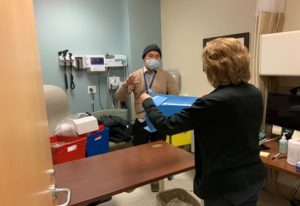
Earlier this year, Raymond Lee, Clinical Pharmacist, at the VA Bedford, NH, (left) reviews flow and practice with Mary-Jean Kellermann, Chief Pharmacy, VA Manchester, NH, Healthcare System. Clinical pharmacists have taken on larger roles at the VA, including managing care of diabetes patients. Photo from the VA New England Healthcare System.
NEW YORK — Diabetes affects one in four veterans—a rate more than double that of the general population. In an effort to improve glycemic control among veterans with diabetes the VA involves clinical pharmacy specialists (CPSs) in medication management, a strategy that has proven beneficial in a studies at a number of centers.
At the VA New York Harbor Healthcare System, for example, a retrospective chart review study assessed the impact of CPSs on patients with uncontrolled Type 2 diabetes who saw a CPS in addition to a primary care physician (PCP) compared to those who saw a PCP alone from Jan. 1, 2011, to Oct. 1, 2016. The CPS held prescriptive authority and ordered, interpreted and monitored laboratory results.1
Among the patients who saw a CPS, there was a significantly significant decrease in hemoglobin A1c p (3.02% vs. 0.93%; P < 0.0001), with most patients reaching their HbA1c goal in six months or less with an average of seven clinic visits in that timeframe. In addition, significantly more patients were taking the appropriate intensity statin in the CPS group (90.7% vs. 73.3%; P = 0.006), the study found.
A retrospective chart review-based study at the Cincinnati VAMC found a 2.2% absolute reduction in the mean HbA1c value among veterans receiving CPS care for up to 18 months, with the greatest reduction observed in the following subgroups: 60- to 69-year-old veterans, veterans with a CAN score of ≥90 and veterans who had five or more CPS visits.2
At the VA Affairs North Texas Healthcare System, a retrospective chart review compared Type 2 diabetes patients referred to CPSs at Fort Worth Outpatient Clinic with those treated at the endocrinologist-managed specialty clinic at the Dallas VAMC. It found no significant difference in the number of patients reaching the HbA1c goal of less than 8% in the two settings. Furthermore, cost-saving analysis demonstrated that continuing to refer patients to CPS could result in a composite cost savings of more than $350,000.3
Improving Outcomes
While these and other studies have shown that using CPSs at the full scope of practice can improve access to care and patient outcomes and even reduce costs, a newly published study led by Ted R. Grabarczyk, associate chief of clinical pharmacy services at the VA Eastern Kansas Health Care System in Topeka, was concerned with how CPSs could further improve patient outcomes using the success of HbA1c trajectories as a guide. “The main rationale,” he said, “was to discern if there are ways we can assist or factors we can modify that can help even more of the patients that we follow to achieve and maintain improved glycemic control.”4
The observational multicenter study examined longitudinal trajectories of HbA1c among a large population of veterans with Type 2 diabetes who had baseline glycosylated hemoglobin (HbA1c) level of 8% and more and received CPS-led diabetes management between July 1, 2013, and July 1, 2017.
Two years of HbA1c measurements were used to group patients into distinct patterns of HbA1c trajectories over time using group-based trajectory modeling. Characteristics associated with successful HbA1c trajectories and association of assigned trajectories with all-cause and diabetes-related hospitalizations were analyzed using logistic regression.
Researchers indicated 4,119 veterans in the study and segmented them into six distinct HbA1c trajectory groups over time: High Gradually Decreasing (n = 325, 7.9%), Moderate Early Decline (n = 1692, 41.1%), Large Early Decline (n = 231, 5.6%), Uncontrolled Stable (n = 1468, 35.6%), Early Decline/Subsequent Increase (n = 266, 6.5%) and Very Uncontrolled Stable (n = 137, 3.3%).
After adjusting for factors including age, sex, race, BMI and enrollment in a telehealth program, the distinguishing factor between successful and less-successful trajectories appears to be the progress made within the first six months of pharmacist management.
“What struck me from that data is most often when there was improvement in terms of their blood sugar control on average it tended to occur early in the course of their management with clinical pharmacy specialists—the first three to six months or so,” Grabarczyk told U.S. Medicine. “That would indicate the importance of really close follow-up and putting a lot of emphasis on the initial few months as we are getting started, and that may set the tone.”
As studies have shown, CPS management can make a difference, the new research might suggest where they can make the biggest difference. “Limited CPS provider supply should be prioritized to managing patients with very elevated initial HbA1c with particular intensity for the first six months,” the authors concluded. “Further work on this topic should investigate interventions to help those patients following likely unsuccessful glycemic trajectories alter course towards a more successful one.”
- Bloom CI. Ku M, Williams M. Clinical pharmacy specialists’ impact in patient aligned care teams for Type 2 diabetes management. J Am Pharm Assoc. 2019: 59(5):717-721. doi: 10.1016/j.japh.2019.05.002
- Schmidt K, Caudill J, Hamilton T. Impact of clinical pharmacy specialists on glycemic control in veterans with Type 2 diabetes. Am J Health Syst Pharm. 2019 Feb 8;76(Supplement_1):S9-S14. doi: 0.1093/ajhp/zxy015.
- Edwards KL, Hadley RL, Baby N, Yeary JC, Chastain LM, Brown CD. Utilizing Clinical Pharmacy Specialists to Address Access to Care Barriers in the Veteran Population for the Management of Diabetes. J Pharm Pract. 2017 Aug;30(4):412-418. doi: 10.1177/0897190016663952.
- Grabarczyk TR, Roberts AW, Mahnken JD, Grauer D. Trajectories of glycemic control with clinical pharmacy specialist management of veterans with Type 2 diabetes. Res Social Adm Pharm. 2021 Aug 26;S1551-7411(21)00314-4. doi: 10.1016/j.sapharm.2021.08.010

